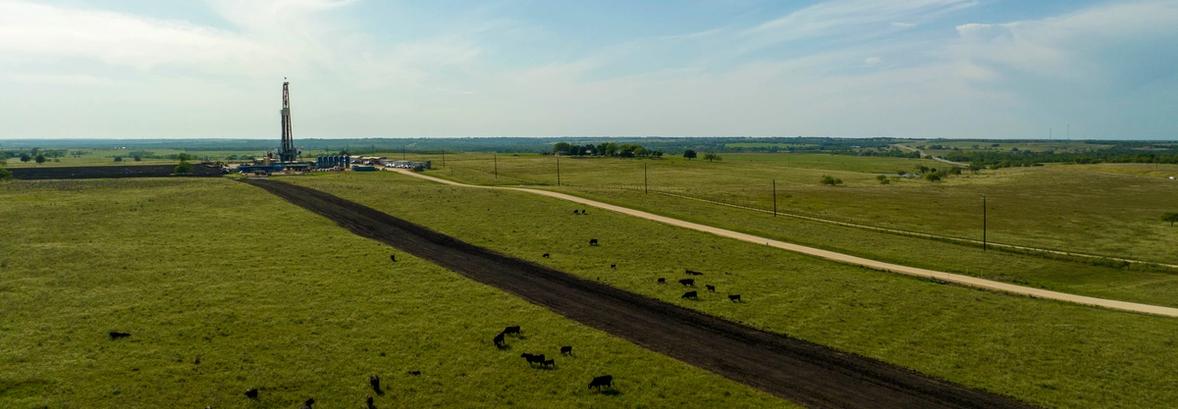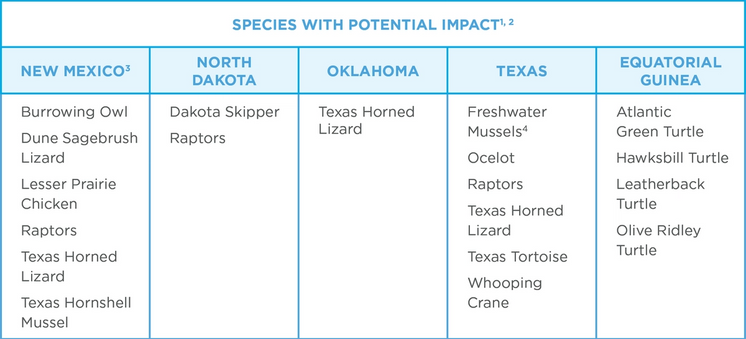

Land Stewardship and Biodiversity
Our Environmental Management Standard, governed by the Responsible Operations Management System (ROMS), requires a pre-site survey for wetlands, endangered species and historical sites. Depending on the situation, we initiate a tabletop or onsite survey to confirm how impacts to sensitive areas will be mitigated.
If areas impacted by our operations are identified, we work with the necessary regulatory agencies to remediate and/or close the site. If a sensitive area is identified in the development plan, we first try to relocate our site if possible. If relocation isn’t viable, we work to get the required permits to develop in the sensitive area and determine appropriate mitigations. Participation in the Candidate Conservation Agreement with Assurances (CCAA) is based on potential operational exposure and decided by each basin to implement voluntary conservation measures for potentially endangered or threatened candidate species. Species of concern identified in the areas where we operate are listed in the table below.
Before construction, we screen each site for endangered species and jurisdictional wetlands and streams and take mitigating actions as needed. Marathon Oil builds and maintains our facilities to minimize the potential for wildlife to access equipment stacks, vents or fluid impoundments. To help protect neighboring streams and wetlands, we implement erosion and sedimentation control systems and use spill prevention measures. We inspect and maintain our sites through routine inspections after significant storm events and repair the erosion and sedimentation control systems as necessary and as conditions allow.
We also have legal, regulatory and contractual obligations to remove and dismantle assets and to restore land or seabed at the end of oil and gas production operations. For more information on our asset retirement obligation, please see our Annual Report on Form 10-K.

Nurturing Grassland Restoration
Marathon Oil works to create more resilient communities by investing in the protection and restoration of natural resources, including water, land and air, as well as increasing environmental education and awareness. In 2022, we continued our support of the National Fish and Wildlife Foundation (NFWF) Northern Great Plains Program (NGPP) in the Bakken, focusing on grasslands restoration, bird species population declines, habitat restoration for mule deer and other wildlife and increased carbon utilization. Over the next three years, the NGPP will partner with local North Dakota organizations to work on:
- Improving livestock management practices on more than 50,000 acres.
- Implementing rotational grazing systems.
- Planting native perennial species.
- Reclaiming ecologically disturbed sites.
- Increasing carbon capture.
- Restoring key habitats for sage grouse and other wildlife.
This program helps to sustain and improve interconnected grasslands and healthy populations of grassland-obligate species, while fostering sustainable livelihoods and preserving cultural identities.
Since 2022, we have invested $200,000 in the NGPP. Our support has helped NFWF restore more than 154,000 acres, remove or improve 375 miles of fencing to wildlife-friendly specifications, place more than 448,000 acres under conservation easement and improve management on more than 2.53 million acres of habitat.
How are we doing?
Your opinion matters. Please take a moment to let us know how useful you find the content on this page.
If you’d like to give us your feedback on the entire report, please fill out the complete survey for the 2022 report.



















